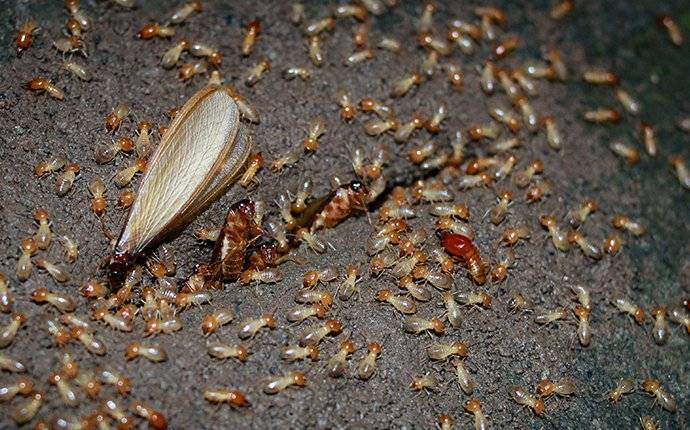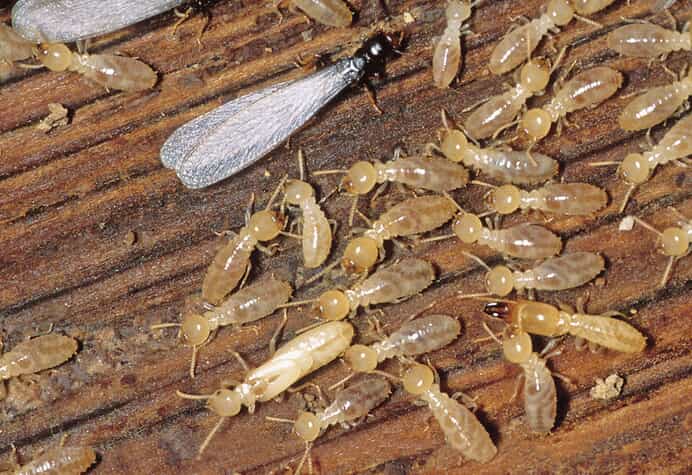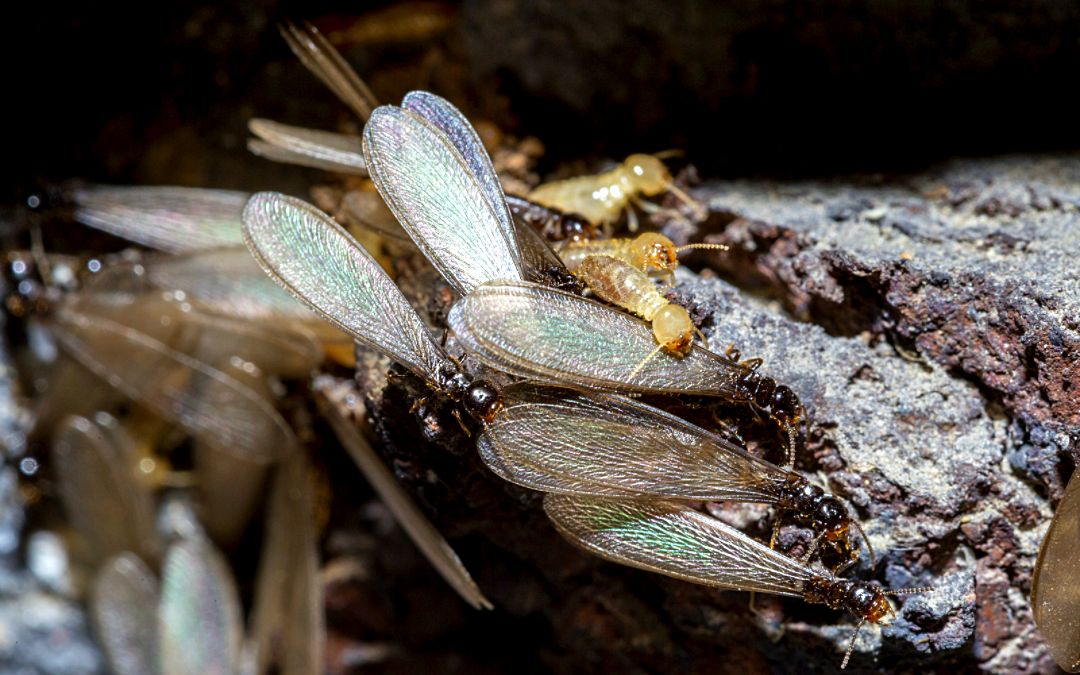Termite swarming can vary in duration but typically lasts between 20 minutes to an hour. The exact time depends on factors like the size of the termite colony and environmental conditions.
Here are the Factors affecting the duration of termites swarming,
- Temperature: Warmer temperatures, around 70-80°F (21-27°C), can lead to longer swarming periods, which may last 20 minutes to an hour.
- Humidity: Higher humidity levels, ideally around 80%, can encourage longer swarming, while lower humidity may shorten it.
- Colony size: Larger termite colonies tend to have more extensive swarming events, potentially lasting several hours.
- Environmental conditions: Factors like rain or strong winds can disrupt swarming, affecting its duration.
- Species variation: Different termite species have varying swarming durations based on their specific biology.
- Time of day: Swarming typically occurs during daylight hours, with the exact time influenced by species and local conditions.
What is termite swarming?

- Definition and purpose of termite swarming
Termite swarming is when winged adult termites, called “alates,” leave their nests to find a mate and start new colonies. The purpose of swarming is for termites to reproduce and establish new territories, as it allows them to expand their populations.
- Different types of termites are involved in swarming
There are three main types of termites involved in swarming:
- Reproductive termites: These are the winged alates responsible for swarming.
- Worker termites: They do not swarm and are responsible for colony maintenance.
- Soldier termites: They protect the colony and also do not participate in swarming.
When do termites swarm?
A. Factors influencing termite swarming:
Temperature: Termites tend to swarm when temperatures are favorable. For many species, this means when the temperature reaches around 70 to 90 degrees Fahrenheit (21 to 32 degrees Celsius).
Humidity: High humidity levels, often associated with spring and early summer, create ideal conditions for termite swarming.
Colony Maturity: Older termite colonies are more likely to produce swarms as they have had time to grow and develop alates (winged termites).
Rainfall: Rain can trigger swarming in some species, possibly because it softens the soil and makes it easier for termites to emerge.
- Seasonal patterns of termite swarming
Termite swarming has distinct seasonal patterns:
Spring is the most common time for termite swarming in many regions, as temperatures rise and humidity levels increase.
Early Summer: In some areas, swarming can continue into early summer, especially in cooler climates.
Geographic Variations: Swarming can vary by region. Due to milder climates, coastal areas may experience swarms at different times than inland areas.
- Implementing preventive measures and termite control strategies
To protect your property from termite swarming and infestations:
Regular Inspections: Schedule professional termite inspections, ideally annually, to detect infestations early.
Moisture Control: Address moisture issues in your home, as termites are drawn to damp environments.
Wood-to-Soil Separation: Ensure wooden structures don’t directly touch the ground.
Chemical Barriers: Consider applying liquid termiticides around your home’s perimeter for long-term protection.
Bait Systems: Install termite bait stations to intercept and eliminate colonies before reaching your home.
Educate Yourself: Learn to recognize signs of termite activity and swarming to identify issues promptly.
In summary, termite swarming is crucial to the termite life cycle, facilitating their reproduction and colony expansion.
The timing of swarming depends on various factors, including temperature, humidity, colony maturity, and local climate conditions.
How long does a termite swarm last?
Termites are destructive pests that can cause significant damage to homes and structures. Understanding the duration of termite swarms is crucial for effective pest control.
Termite swarms typically last for a short period, ranging from a few minutes to a couple of hours.
Addressing the durability of termite swarming is important as it allows homeowners and pest control professionals to identify and tackle termite infestations promptly, minimizing potential damage and preserving the integrity of the structure.
Let me Explore the durability of termite’s swarm lastingness for facilitating the pest control process.
Duration of termite swarming events
Termite-swarming events typically endure for a relatively short period. On average, a termite swarm lasts around 30 minutes to an hour. However, in some cases, swarms can extend for a few hours, depending on specific circumstances.
Factors that affect the duration of termite swarms
Several factors can influence how long a termite swarm lasts:
Weather Conditions: Calm, warm, and humid weather conditions are conducive to longer swarming events. Adverse weather like rain, wind, or extreme temperatures can shorten the swarming duration.
Colony Size: Larger termite colonies tend to have more alates (winged termites), which can result in longer and more extensive swarms.
Termite Species: Different termite species exhibit variations in swarming behavior, with some having shorter swarming events than others.
Implications of termite swarming for homeowners
A. Understanding the signs of termite swarms Being able to recognize the signs of termite swarms is essential for homeowners. Watch for sudden appearance of winged termites inside your home, especially near light sources or windows. Additionally, discarded termite wings near entry points can indicate a recent swarm.
B. Potential risks and damage caused by termite swarms
Termite swarming is a red flag that there is a nearby termite colony, and this poses significant risks for homeowners. Termites can silently damage wooden structures in your home, potentially leading to expensive repairs. The longer termites go unnoticed, the more extensive the damage becomes.
C. Importance of proactive termite prevention and control measures
To protect your home from termite damage, it’s crucial to take proactive steps:
Regular Inspections: Schedule professional termite inspections at least once a year to detect infestations early.
Moisture Control: Address any moisture issues in your home, as termites are attracted to damp environments.
Wood-to-Soil Contact: Ensure that wooden structures, such as decks or foundations, do not directly touch the soil.
Termite Treatments: Consider using chemical or bait systems as a preventive measure or for controlling existing termite populations.
In conclusion, termite swarming events typically last between 30 minutes to an hour, with various factors like weather, colony size, and termite species affecting the duration. Recognizing the signs of swarming is crucial for homeowners, as it signals the presence of termites that can cause substantial structural damage. Taking proactive measures for termite prevention and control is essential to safeguard your home from these destructive pests.
Dealing with termite swarms

- Steps to take when encountering termite swarms
When you encounter termite swarms around your home, follow these steps:
Do not panic: Stay calm and avoid disturbing the swarming termites.
Avoid direct contact: Do not touch or crush the termites, as they can release chemicals that signal danger to the colony.
Keep lights off: Turn off exterior lights to minimize attraction to your home.
Ventilate your home: Open windows and doors to encourage the termites to flee your property.
Consult a professional: Contact a pest control expert for an inspection and advice on how to proceed.
- Professional assistance and DIY prevention methods
Professional Pest Control: Seek help from a licensed pest control company. They have the expertise and tools to assess the extent of the infestation and apply effective treatments.
DIY Prevention: While professional help is crucial, you can also take some preventive steps on your own:
- Seal cracks in your home’s foundation and walls
- , and fix moisture issues like leaky pipes and clogged gutters.
- Keep firewood and wood debris away from your house.
- Use termite-resistant materials for construction when possible.
- Install termite bait stations as a preventive measure.
- Long-term strategies for termite swarm prevention
To prevent future termite swarms and infestations:
Regular Inspections: Schedule annual termite inspections, even if you haven’t seen swarms. Early detection is key.
Moisture Control: Maintain proper drainage and ventilation to reduce moisture buildup, which attracts termites.
Wood-to-Soil Separation: Ensure wooden structures do not touch the soil to deter termite access.
Chemical Barriers: Consider applying liquid termiticides around your home’s perimeter for long-term protection.
Bait Systems: Install termite bait systems that intercept and eliminate colonies before reaching your home.
Educate Yourself: Learn about the signs of termite activity and swarming to identify issues promptly.
In summary, when you encounter termite swarms, stay calm and take measures to reduce their impact.
FAQs
How long do termite swarms last?
Termite swarms can vary in duration, typically lasting anywhere from 20 minutes to an hour, but this can depend on environmental factors and the size of the colony.
When do termites typically swarm?
Termite swarming season varies by species and location, but it often occurs in spring when weather conditions are favorable for reproductive termites to establish new colonies.
How often do termites swarm?
Termite swarms generally happen once a year for each colony, though the timing can differ for various species.
What triggers termite swarming?
Swarming is triggered by environmental factors like temperature and humidity and often takes place after rain to help termites avoid desiccation.
What do termite swarmers look like?
Termite swarmers, or alates, have wings and are typically darker than worker termites. They have a pair of equal-sized wings and straight antennae.
Are termite swarmers harmful to humans?
No, termite swarmers aren’t directly harmful to humans. They are primarily focused on finding a suitable mate and location to establish a new colony.
How can I tell if a swarm is of termites or flying ants?
Termites and flying ants can look similar during swarms, but termites have straight antennae, equal-sized wings, and a broad waist, while ants have elbowed antennae, unequal-sized wings, and a narrow waist.
Can I prevent termite swarms near my home?
No, You cannot prevent termite swarms near your home, but you can reduce the risk of termite infestations by maintaining a dry and well-ventilated home and scheduling regular termite inspections.
Are swarming termites a sign of an infestation?
Yes, swarming termites, especially indoors or near your home, strongly indicate an existing termite colony and should prompt immediate professional inspection and treatment.
What should I do if I encounter a termite swarm indoors?
If you find indoor termite swarms, collect some for identification and call a pest control expert for a full inspection and proper treatment.
Conclusion
Termites typically swarm for a short period, lasting anywhere from a few minutes to a couple of days, depending on various factors such as weather conditions and the termite species.
Homeowners need to be aware of termite swarms as they indicate the presence of a termite colony nearby.
Identifying these swarms early on can help homeowners take timely action to prevent potential damage to their property and seek professional assistance for termite control.

